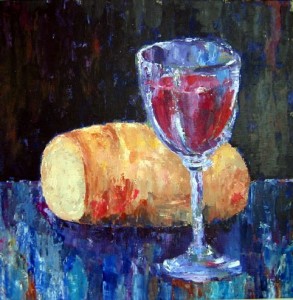What Jesus Does at Meals

A few paragraphs to follow up on some of the main thoughts from yesterdays homily. I hope the truth of the words finds a deep place of resonance in your soul.
Eugene Peterson in his book, Living the Resurrection, references a work by Anglican monk, Dom Gregory Dix, in which Dix noted a sequence of four verbs to describe what Jesus does at meals. Whether it’s the feeding of the 5,000, the 4,000, the Last Supper, or the Emmaus supper, Jesus engages in a four-fold sequence of taking food, blessing it, breaking and giving it away. Peterson then relates Jesus’ actions in our own lives particularly as we seek to live out the resurrection in our present experience.
Jesus takes what we bring to him — our bread, our fish, our wine, our goats, our sheep, our sins, our virtues, our work, our leisure, our strength our weakness, our hunger, our thirst, whatever we are. At every table we sit down to we bring first of all and most of all ourselves. And Jesus takes it — he takes us.
Jesus blesses and gives thanks for what we bring, who we are in our bringing. He takes it to the Father by the Holy Spirit. Whatever is on the table and is around the table is lifted up in blessing and thanksgiving. He offers us up and brings us into the Godhead, into the operation of the Trinity. Jesus doesn’t criticize or condemn or reject our offering. “Two fish is all you can come up with?” Can you imagine Jesus saying that to you at the table?
Jesus breaks what we bring to him. All too often we come to the table with our best manners and a pose of impenetrable self-sufficiency. We’re all surface, all role-polished and poised performers in the game of life. But Jesus is after what is within, and he eposes the insides-our inadequacies. At the table we’re not permitted to be self-enclosed. We’re not permitted to remain self-sufficient. We are taken into the crucifixion. We dramatize it as we eat the common food. The breaking of our pride and self-approval opens us up to the new life, to new action. Everything on the table represents some kind of exchange of life, some sacrifice to our host. If we come crusted over, hardened within ourselves in lies and poses, he breaks through and brings new life. “A broken and contrite heart, O God, thou wilt not despise” (Psalm 51:17). We discover this breaking first in Jesus. Jesus was broken, his blood poured out. And now we discover it in ourselves.
Then Jesus gives back what we bring to him, who we are. But it is no longer what we brought. Who we are, this self that we offer to him at the Table, is changed into what God gives, what we sing of as Amazing Grace. Transformation takes place at the Table as we eat and drink the consecrated body and blood of Jesus. A resurrection meal. “Christ in me.”

No comments